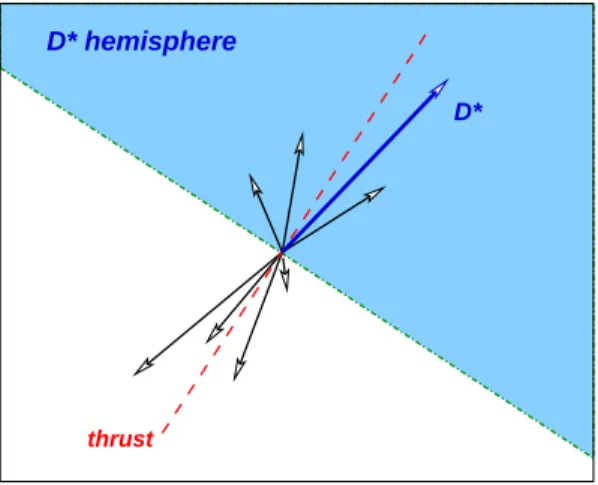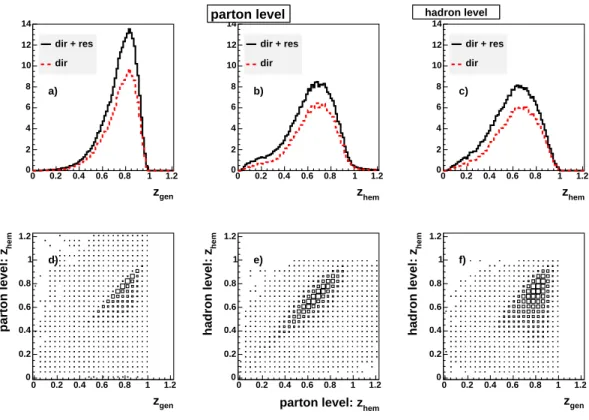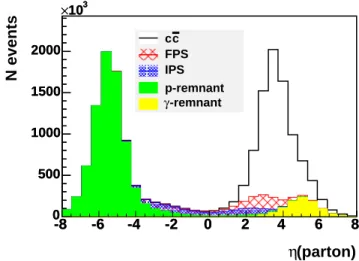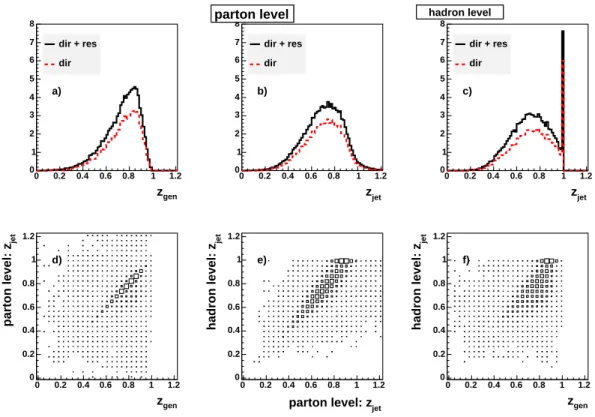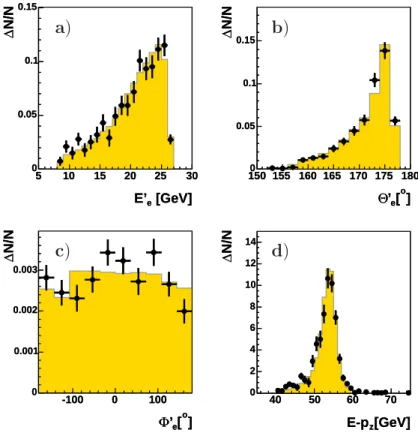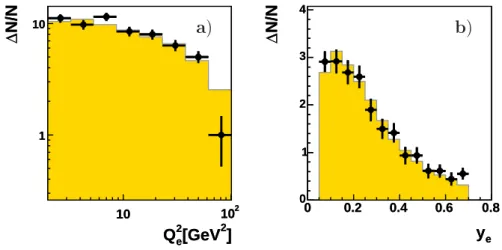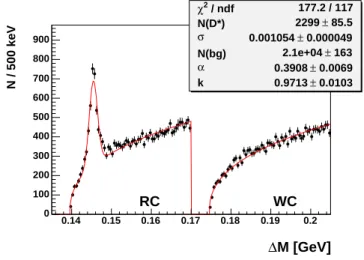Measurement of Charm
Fragmentation in DIS at HERA
Dissertation
zur Erlangung des Doktorgrades des Fachbereichs Physik
der Universit¨ at Hamburg
vorgelegt von
Zuzana R´ urikov´ a
aus Bratislava
angefertigt am
Max-Planck-Institut f¨ur Physik, M¨unchen (Werner-Heisenberg-Institut)
Hamburg 2005
Gutachter der Disputation: Prof. Dr. G. Heinzelmann Dr. H. Jung
Datum der Disputation: 02.03.2006
Vorsitzender des Pr¨ufungsausschusses: Dr. H. D. R¨uter Vorsitzender des Promotionsausschusses: Prof. Dr. G. Huber Dekan des Fachbereichs Physik: Prof. Dr. G. Huber
Abstract
The charm fragmentation function has been studied in deep inelasticep collisions with the H1 detector at HERA. The data were analyzed in the kinematic range given by the photon virtuality 2< Q2 <100 GeV2 and the inelasticity 0.05< y <0.7.
The differential cross section of D∗-meson production as a function of two scaling variables sensitive to fragmentation, zhem and zjet, was mea- sured in the D∗-meson visible range defined by cuts on pseudorapidity
|η(D∗)| < 1.5 and transverse momentum 1.5 < pt(D∗) < 15 GeV. In the case of the zhem observable, the momentum of the charm quark has been approximated by the momentum of a suitably defined hemisphere in the photon-proton center-of-mass frame, whereas in the case of the zjet observable, the charm quark momentum was approximated by the momentum of the reconstructed jet associated with the D∗-meson. A transverse energy Etγp(D∗jet)>3 GeV was required in the latter case.
Both distributions were used to extract the parameters of the non- perturbative Peterson and Kartvelishvili fragmentation functions for the Monte Carlo models RAPGAP/PYTHIA and CASCADE/PYTHIA and for the next-to-leading-order massive QCD calculation HVQDIS.
In dieser Arbeit wird das Studium der Charm-Fragmentations-Funktion anhand der H1-Daten in tief unelastischer Streuung beschrieben. Die analysierten Daten liegen in dem kinematischen Bereich, der von dem negativen Viererimpuls¨ubertrag zum Quadrat 2 < Q2 < 100 GeV2 und der Unelastizit¨at 0.05< y < 0.7 festgelegt wird.
Der differentielle Wirkungsquerschnitt der D∗-Produktion wird in Abh¨angigkeit von zwei Skalenvariablen die sensitiv auf die Fragmenta- tion sind, zhem und zjet, in dem sichtbaren Bereich der D∗-Produktion gemessen. Dieser Bereich wird definiert durch die Pseudorapidit¨at
|η(D∗)| < 1.5 und dem Transversalimpuls 1.5 < pt(D∗) < 15 GeV.
F¨ur die Observable zhem wird der Impuls des Charm Quarks anhand einer geeignet definierten Hemisph¨are im Photon-Proton Schwerpunkt- system abgesch¨atzt. Bei der Observablen zjet wird der Impuls des Charm Quarks aus dem Viererimpuls des rekonstruierten Jets definiert, der das D∗-Meson beinhaltet. F¨ur den Jet wird eine Transversalenergie von Etγp(D∗jet)>3 GeV gefordert.
Aus der Verteilung der Observablen werden die Parameter f¨ur die nicht perturbativen Fragmentations-Funktionen von Peterson und Kartvel- ishvili f¨ur die Monte-Carlo-Modelle RAPGAP/PYTHIA und CAS- CADE/PYTHIA und f¨ur eine massive QCD-Rechnung (HVQDIS) in n¨achst h¨oherer Ordnung extrahiert.
Contents
Introduction 1
1 Theoretical Framework 3
1.1 Quantum Chromodynamics . . . . 3
1.2 Deep-Inelastic Scattering . . . . 4
1.3 DIS Kinematics . . . . 5
1.4 Proton Structure . . . . 6
1.5 Quark Parton Model . . . . 7
1.6 Ultraviolet and Infrared Divergencies . . . . 8
1.7 Factorization and Evolution Equations . . . . 9
1.8 Fragmentation . . . 11
1.8.1 Heavy Quark Fragmentation . . . 13
1.8.2 Phenomenological Parametrizations . . . 13
1.9 Charm Production in epScattering . . . 15
1.10 Monte Carlo Generators . . . 16
1.10.1 String fragmentation model . . . 18
1.11 QCD NLO Calculations . . . 19
1.11.1 HVQDIS . . . 20
2 Experimental Methods for the Measurement of Fragmenta- tion 23 2.1 Fragmentation in e+e− Collisions . . . 23
2.2 Fragmentation in ep Collisions . . . 24
2.3 Hemisphere method . . . 25
2.4 Jet method . . . 27
2.4.1 Jet Algorithm . . . 27
2.5 Fragmentation Observables on MC Generator Level . . . 29
2.5.1 Hemisphere observable . . . 30 i
2.5.2 Jet Observable . . . 32
3 H1 Experiment at HERA 35 3.1 HERA Accelerator . . . 35
3.2 H1 Detector . . . 35
3.2.1 Tracking System . . . 37
3.2.2 Calorimeters . . . 40
3.2.3 Trigger System . . . 41
4 Selection of D∗-Mesons 45 4.1 Online Selection . . . 45
4.2 Data Quality Cuts . . . 47
4.2.1 Run Selection . . . 47
4.2.2 Event Vertex . . . 48
4.3 Selection of DIS Events . . . 48
4.3.1 Scattered Electron . . . 48
4.3.2 The Energy Balance . . . 50
4.3.3 Reconstruction of the Kinematics . . . 52
4.3.4 DIS Kinematic Range . . . 53
4.4 Reconstruction of D∗-mesons . . . 53
4.4.1 The D∗ Decay Mode . . . 53
4.4.2 D∗ Finder Algorithm . . . 54
4.4.3 D∗ Signal Extraction . . . 55
4.4.4 Particle Identification . . . 57
4.4.5 Signal Extraction in MC . . . 59
5 Fragmentation Measurement 61 5.1 Hadronic Final State . . . 61
5.2 Trigger Efficiency . . . 63
5.3 Hemisphere Observable: zhem . . . 68
5.4 Jet Observable: zjet . . . 70
5.5 Correcting Data to Hadron Level . . . 70
5.5.1 Subtraction of Beauty Contribution . . . 72
5.5.2 Unfolding Method . . . 72
5.6 Systematic Uncertainties . . . 75
5.6.1 Experimental Systematic Uncertainties . . . 76
5.6.2 Theoretical Systematic Uncertainties . . . 78
CONTENTS iii
6 Results 83
6.1 Extraction Procedure and Treatment of Correlated Systematic
Errors . . . 83
6.2 Parameter Extraction for RAPGAP . . . 84
6.3 Parameter Extraction for CASCADE . . . 88
6.4 Hemisphere Method Revisited . . . 91
6.5 Parameter Extraction for NLO Calculations . . . 95
6.6 Comparison with e+e− Experiments . . . 100
Conclusions and Outlook 105
A Reweighting Procedure 107
B Consistency Check of Experimental Methods 109 C Effect of Higher Charmed Resonances 111
Introduction
During the last decades there has been large progress achieved in the field of high energy physics, which led to the formulation of the standard model.
The standard model describes all known physics phenomena except gravity.
It includes the theory of electro-weak interactions and the theory of strong interactions, also called quantum chromodynamics (QCD). The theoretical predictions, for both theories, are usually based on perturbative calculations.
However in QCD, due to the nature of the strong coupling, only processes with large momentum transfer can be calculated perturbatively, which limits the predictive power of this theory.
An interesting opportunity for testing QCD offer the processes which involve production of heavy quarks (charm and beauty), since the heavy quark mass already provides a hard scale. This hard scale allows to extend the range of applicability of perturbative calculations. Due to confinement, single partons cannot be directly observed, as they are bound within hadrons.
This introduces a large uncertainty in the comparison of measured data on exclusive production of charmed hadrons with theoretical predictions.
The transition of a heavy quark to a heavy meson (often referred to as fragmentation) is usually described by phenomenological models, since it is not entirely perturbatively calculable. One of the major characteristics of this process is the energy fraction which is transferred from the quark to the created hadron, which is given by the non-perturbative fragmentation function.
According to the factorization theorem, the non-perturbative fragmenta- tion function should be universal, i.e. independent of the charm production mechanism. Up to now, the parameters of phenomenological models for frag- mentation have been almost exclusively determined from e+e− annihilation experiments, and are widely used in ep and pp collider experiments.
However, the factorization theorem has been proven only for a few pro- 1
cesses, since the mathematical apparatus is very demanding. Apart from the question of theoretical proof, it is important to experimentally test whether universality of the fragmentation function really holds.
In this thesis the charm fragmentation function has been measured in deeply inelastic ep collisions at the H1 experiment. The charm events are tagged by reconstructing a D∗±-meson via one of its decay channels. Since the choice of a suitable observable sensitive to the fragmentation function is not so straight forward in ep-scattering than for example in e+e− annihila- tion, two different definitions have been investigated in parallel: the first in close analogy to e+e− - the hemisphere observable, the other making use of reconstructed jets - the jet observable.
The thesis is organized as follows. In the first chapter the theoretical foundations are given. In the second chapter the experimental methods for the measurement of fragmentation are introduced. A short description of the H1 detector with main focus on detector components relevant for this analysis is given in chapter 3. Then the data selection, reconstruction of event kinematics, D∗±-meson tagging as well as the measurement of the fragmentation spectra are discussed in chapters 4 and 5. In chapter 6 the parameters of the non-perturbative fragmentation functions are extracted for different Monte Carlo models and next-to-leading order calculations.
Chapter 1
Theoretical Framework
1.1 Quantum Chromodynamics
Quantum chromodynamics (QCD) is the theory of the strong interaction, one of the four fundamental forces in nature. It describes the interaction between quarks and gluons and at the same time gives a hint for their somewhat un- conventional behavior of being bounded in the hadrons and not manifesting themselves directly as other elementary particles (e.g. leptons) do. QCD was developed in the 1970s as a field theory, where interaction between quarks is mediated by a massless spin=1 boson, the gluon. The partons (quarks and gluons) are found to have an additional degree of freedom called color charge.
The color charge is analogous to the electric charge, except that it has three values rather than one (r=red, g=green and b=blue). Quarks carry only one type of color whereas the gluons are bicolored, carrying one color and one anticolor.
The major difference between QCD and quantum electrodynamics (QED) is that gluons can couple to each other since they carry color, whereas in QED the photons are chargeless. The consequence of gluon self-coupling is that the strong coupling αs ’runs’ in the opposite direction to the electromagnetic coupling and becomes very large at low momenta, ensuring that quarks and gluons are confined within color singlet hadrons.
In principle QCD can completely predict the behavior of partons on the basis of equations of motion which can be obtained from the QCD La- grangian. But in practice this is far from being the case, as these equations cannot be solved directly. One of the frequently used techniques, which leads
3
to testable predictions is the use of perturbation theory. For QCD processes involving exchanges of sufficiently large momenta (hard subprocesses) αs is small enough for the perturbative approach to be valid. The problem then is to extend the domain of validity to soft processes, where the involved momenta are smaller and αs becomes larger. To do this requires informa- tion on the dynamics of partons inside the interacting hadrons as well as how partons emerging from the hard subprocess turn into a jet of observ- able hadrons. Appropriate descriptions of these two soft aspects of QCD are expected to be universal according to the factorization theorem. After having been measured in simple cases, they can be applied to all other QCD processes.
1.2 Deep-Inelastic Scattering
Deep-inelastic scattering (DIS) plays an important role in our understanding of the structure of matter. The proton structure can be investigated using lepton-nucleon scattering where the boson emitted by the pointlike lepton acts as a probe of the nucleon. This provides a much simpler probing mecha- nism than in nucleon-nucleon collisions in which both participating particles are compound objects and thus the determination of event kinematics gets more difficult.
In DIS experiments at HERA, where electrons or positrons collide with protons at high energy, the lepton (l) interacts in leading order with one of the quarks in the proton by exchange of a virtual gauge boson (see figure 1.1). Depending on the exchanged boson, two major processes can occur.
The process, ep→eX, where the exchanged boson does not carry any elec- tric charge (virtual photon or Z0 boson), is classified as neutral current (NC). The second process,ep→νX, which leads to the exchange of an elec- trically charged boson (W±) and a different final state (a neutrino instead of a scattered electron) is classified as charged current (CC). In both cases X stands for the hadronic final state which includes the proton remnant, corresponding to the remainder of the proton which did not actively take part in the hard interaction.
1.3. DIS KINEMATICS 5
Figure 1.1: Feynman diagram of deep inelastic ep scattering.
1.3 DIS Kinematics
The kinematics of a DIS event can be parametrized in terms of Lorentz invariant quantities s, Q2, x, y and W defined as follows:
• The center-of-mass energy squared
s= (k+P)2= 4EeEp+m2e+m2p ≈4EeEp (1.1) is determined by the energies of the colliding beams Ee and Ep (in this analysis it has a value of 101568 GeV2 with Ee = 27.6 GeV and Ep = 920 GeV).
• The negative square of the four-momentum transfer or virtuality Q2 =−q2 =−(k−k)2 (1.2) represents the mass squared of the virtual boson. Q determines the hardness or in other words the transverse resolving power of the inter- action.
• The Bjorken scaling variable x= Q2
2P q (0≤x≤1) (1.3)
can be interpreted in leading order as the fraction of the proton mo- mentum carried by the struck parton in the infinite momentum frame of the proton.
• The inelasticity
y = qP
kP (0≤y≤1) (1.4)
is the relative energy transfer from the lepton to the hadronic system in the proton rest frame.
• The energy of the boson-proton center-of-mass system W2 = (q+P)2 =Q2(1
x−1) +m2p ≈ys−Q2 (1.5) is equal to the invariant mass of the hadronic final stateX.
Neglecting the electron and proton rest masses, the kinematic variables are related by Q2 = sxy. Hence for fixed s the kinematics of the inclusive scattering process can be completely described by any set of two independent variables out of Q2,x, y and W.
On the basis of the virtuality of the photon one distinguishes between two kinematic regimes. Interactions with small momentum transfer squared, Q2 ≈ 0, where the exchanged photon is almost real are called photopro- duction processes. With increasing momentum transfer the wavelength of the virtual photon decreases (λ ∼ 1/Q). For Q2 values typically greater than 1 GeV2 the wavelength becomes smaller than the proton size, making it possible to resolve its internal structure; this regime is called DIS.
1.4 Proton Structure
Neglecting theZ0 boson exchange contribution which is insignificant at pho- ton virtuality below 1000 GeV2, the neutral current double differential cross section for ep scattering (see e.g. [34]) can be written as a function of two structure functions F1(x, Q2) and F2(x, Q2):
d2σNC
dxdQ2 = 4παem2 xQ4
xy2F1(x, Q2) + (1−y)F2(x, Q2)
, (1.6)
1.5. QUARK PARTON MODEL 7 whereαemis the electromagnetic coupling, and the quantitiesx, y andQ2 have been defined in the previous subsection. The structure functions are interpreted as being related to the momentum distribution of the charged partons within the proton, but they do not explicitly contain knowledge about the nature of the interaction.
Since the exchanged virtual photon is massive (Q2 > 0), it can have all three helicity states, λ = 0,±1. Hence the photo-absorption cross section can be written as a sum of two contributions, σT and σL, which arise from transversely (λ =±1) and longitudinally (λ = 0) polarized photons respec- tively. It is found that 2xF1 is proportional toσT and thatF2 is proportional to σL+σT. Introducing the longitudinal structure function
FL=F2−2xF1, (1.7)
which is related to the exchange of longitudinally polarized photons, equation 1.6 can be rewritten as
d2σNC
dxdQ2 = 4πα2em xQ4
(1−y+y2
2)F2(x, Q2)− y2
2 FL(x, Q2)
(1.8) The structure functionsF2 is then extracted by measuring the differential cross sections depending on x and Q2. FL can be determined by measuring in addition the dependence on y at fixed x and Q2.
1.5 Quark Parton Model
The quark parton model (QPM) [30] was used to interpret the first measured data of inelastic ep scattering at the end of the sixties. In this model the proton is composed of charged pointlike spin 1/2 partons. For processes with large Q2 where the hard interaction time scale is much shorter than the interaction between the partons, the partons can be considered as non- interacting. Therefore γ scatters incoherently, i.e. elastically on one of the partons of the proton. In QPM the internal structure of the proton can be expressed in terms of parton density functions fi(x) (PDFs), which denote the probability to find a parton of type i inside the proton, carrying fraction x of the proton’s momentum. The structure functions can then be written as
F2(x) =
nf
i=1
e2ixfi(x) FL(x) = 0 (1.9)
The sum runs over allnf quark flavors andei is the electric charge of thei-th flavor. In this ’naive’ model the structure function depends only on Bjorken x and not onQ2.1
Although it was found in those early days of deep-inelastic scattering ex- periments that the QPM described data quite well, it could not explain why the quarks were bound inside the proton. Also the assumption that the pro- ton consisted only of charged quarks was indirectly proven to be false, since the sum over momenta of charged partons was found to be approximately 50% of the proton’s total momentum. The missing momentum had to be therefore carried by neutral partons - the gluons, for which later at thee+e− storage ring PETRA at DESY convincing evidence was found.
By introducing gluon radiation into the QPM picture, the scaling behav- ior of the structure functions is violated as they now depend on bothx and Q2. The quarks in the proton can radiate gluons, and the gluons themselves can radiate gluons or split into quark-antiquark pairs as illustrated in figure 1.2. These properties lead to scaling violation, but also to divergencies in cross section calculations.
Figure 1.2: Feynman diagrams for gluon radiation processes: a) q →qg, b) q→gq, c) g →q¯q and d) g →gg.
1.6 Ultraviolet and Infrared Divergencies
One should distinguish between two types of divergencies, namely the ul- traviolet and the infrared divergence. The ultra violet divergencies arising from virtual loop corrections can be absorbed into the running of the strong coupling αs(µr), which depends on the renormalization scaleµr given by the
’hard’ scale of the interaction. In the lowest orderαs is given by αs(Q2) = 12π
(33−2nf)log(Q2/Λ2QCD), µr=Q (1.10)
1This property is called scaling (Bjorken scaling).
1.7. FACTORIZATION AND EVOLUTION EQUATIONS 9 where ΛQCD ≈ 0.2 GeV is an experimentally determined parameter, and nf denotes the number of quark flavors considered in virtual loop corrections to the gluon propagator. For Q2 Λ2QCD the coupling is small, and thus the interaction is asymptotically free. With decreasing hard scale Q2 → ΛQCD, the coupling becomes large (which presumably leads to confinement) and perturbative expansions cannot converge.
In case of real gluon radiation the cross section can be divergent in two regions. The case where the emitted gluon is moving in the direction of the outgoing quark is referred to as collinear divergence, while soft divergence refers to the case where the emitted gluon is soft, i.e. has low energy. It can be shown that both cases are of the infrared type which means that they involve long distances.2 The long distance part is mostly sensitive to the partonic structure of hadrons and the hadronization mechanism. Unfortunately for infrared divergencies there does not exist such an elegant solution like the renormalization in the case of ultraviolet divergencies.
1.7 Factorization and Evolution Equations
Inspite of the plague of infrared divergencies it is possible to provide theo- retical predictions within a perturbative quantum chromodynamics (pQCD) scope: the infrared divergencies at long distances can be separated from the hard interaction which is perturbatively calculable. This mechanism is called f actorization. According to the factorization theorem the long distance part still contains infrared singularities but has the advantage of being universal (independent of the type of hard subprocess).
The ’final state’ infrared divergencies3can be absorbed into non-calculable fragmentation functions (FFs). They are used to parametrize the transition from partons to hadrons (see section 1.8 for more details). On the other hand, ’initial state’ infrared divergencies4 are absorbed into parton density functions (section 1.5). Schematically the total cross section for a produc- tion of specific hadron hcan then be written as a convolution of PDFs, hard
2From perturbative point of view the cross-section can be split into a short distance part (hard scale involved), which is infrared and collinear safe, and a long distance part (soft scale involved) which contains infrared and collinear singularities.
3This refers to gluon radiation from partons coming out of the hard subprocess.
4This refers to gluon radiation from partons entering the hard subprocess.
partonic cross section ˆσ and fragmentation function Dh: σ=
i
k
fi(x, µf)⊗σˆiγ→kX(αs(µr), µf)⊗Dkh(z, µf), (1.11) where the indexiruns over all partons entering the hard subprocess, and the indexk runs over partons emerging from hard subprocess. The long distance part as well as the hard subprocess cross section ˆσ depend on the choice of factorization scale µf (similar to µr) and the factorization scheme. Once the PDFs and FFs are known at some starting scaleµ0, they can be extended to a different scale by the QCD evolution equations. The evolution equations are derived considering the possible gluon radiation and gluon splitting processes.
Such process can occur several times which can lead to a gluon ladder in case of initial state radiation as shown on figure 1.3 (left).
Q
CCFM
BFKL
1/x
2
DGLAP
Figure 1.3: Left: gluon emissions in parton evolution, the so called gluon ladder. Right: a schematic overview of the differences in the DGLAP, BFKL and CCFM evolution schemes. The direction of particular evolutions are drawn in the 1/x−Q2 plane.
For the determination of PDFs there exist several approaches of summing the contributions from all ladder type diagrams. They are based on different assumptions concerning the ordering of fractional longitudinal momenta xi,
1.8. FRAGMENTATION 11 the transverse momenta kt,i, which are related to the virtualities ki2 and the radiation angles θi of radiated partons. The DGLAP, BFKL and CCFM evolutions are described in the following.
DGLAP In this approach [35] the partons in the gluon ladder follow a strong ordering in transverse momenta kt2,i k2t,i−1 kt2,i−2 ..., while for the fractional longitudinal momenta there is only a soft ordering xi < xi−1 < xi−2 < .... The DGLAP formalism is applicable only, if the longitudinal momentaxP are larger than the transverse momenta, which is only valid in the region of large Q2 and intermediate to large x.
BFKL In the regime of very low x and moderate Q2 the BFKL approach [41] is more appropriate. In contrast to the DGLAP formalism, the partons in the ladder follow a strong ordering in fractional longitudinal momentum xi xi−1 xi−2 ...., while the transverse momenta kt
are not ordered.
CCFM The CCFM approach [19] attempts to unify the treatment for both the xand Q2 dependencies of the parton distributions throughout the kinematic plane. According to CCFM, the emission of gluons is only allowed in the angular ordered region of phase space. At small x the CCFM evolution equation is ’equivalent’ to BFKL and at large x to DGLAP evolution.
The difference between DGLAP, BFKL and CCFM approach is shown schematically in figure 1.3 (right). DGLAP predicts the Q2 evolution of the structure function (parton distribution functions measured as a function of x at some starting value Q20 can be evolved in Q2), BFKL evolution in x, whereas CCFM allows to evolve in Q2 and xat the same time.
1.8 Fragmentation
The fragmentation function formalism is to some extent similar to the treat- ment of the parton density functions. The fragmentation process describes in general how an energetic parton becomes a hadron (this is in fact the op- posite scenario to that of PDFs). There are two independent aspects which have to be described by the process of fragmentation.
The first one involves the probabilities of a quark to hadronize into var- ious types of hadrons. The second one deals with the probability density distribution of the energy fraction z, which is transferred in the fragmenta- tion process from parent parton to the newly created hadron. Usually this fraction is defined as
z = (E+pL)hadron
(E+p)parton , (1.12)
where the energy is combined with the momentum component parallel to the parton direction. This has the advantage of being invariant under a boost along the parton direction.
As already mentioned in the previous section (see eq. 1.11), usually one assumes that the fragmentation function can be factorized. The choice ofµf, which distinguishes between the long distance and short distance part of the process, is theoretically not clearly defined and is in some sense arbitrary. The precise definition of a FF for a partoni fragmenting to hadron h - Dhi(z, µf) depends on how much of the quark evolution, after its production, is absorbed into the perturbative partonic cross section ˆσ, and how much is assigned to the FF itself. Therefore, fragmentation functions can be further decomposed into perturbative and non-perturbative parts Dp and Dnp according to
Dhi(z, µf) =Dp,i(µf)⊗Dhnp,i = 1
0
1 0
Dp,i(x, µf)Dhnp,i(y)δ(xy−z)dxdy (1.13) The perturbative FF Dp,i(z, µf) takes into account further final state gluon emissions, and the non-perturbative FF Dnph ,i(z), which corresponds to formation of bound hadron states is then considered to be universal.5 The non-perturbative function is usually parametrized by different phenomeno- logical models which will be discussed later.
The perturbative fragmentation function Dp,i(x, µf) diverges for light quarks, but in the case of heavy quarks (charm and bottom), where the quark mass mQ is significantly larger than the QCD scale Λ, better theo- retical control can be achieved. In particular, the mass provides a physical infrared cutoff for collinear radiation making a part of the fragmentation pro- cess accessible to perturbative methods. Usually DGLAP inspired evolutions are used in order to resum the perturbative part, defined by the evolution in Q2 down to the scale of the heavy quark massmQ.
5Universal here means depending neither on the type of hard subprocess, nor on the scale at which parton was produced.
1.8. FRAGMENTATION 13
1.8.1 Heavy Quark Fragmentation
Whereas light quark fragmentation is characterized by small energy transfers to the created hadrons, following roughly the behavior z−1(1−z)2, a quite different dependence is expected for the fragmentation of heavy quarks into hadrons. This can be readily seen from simple kinematic considerations as first pointed out by Bjorken and Suzuki [13].
000000 000000 000 111111 111111 111
Q
q q
zP q=
P=m vQ
m vq
Q
q
H(Q q)
Figure 1.4: Fragmentation of heavy quark Q into heavy mesonH(Q¯q).
When a light antiquark ¯q from the vacuum (or a diquark qq for baryon production) gets attached to a fast moving heavy quark Q, it decelerates the heavy quark in the fragmentation process only slightly, see figure 1.4. This follows from the momentum conservation law and the requirement vQ = vq for binding of Qq in a hadron. Thus Q and the heavy hadron H(Q¯q) (or H(Qqq) respectively) should carry almost the same energy, resulting in a fragmentation function that peaks near z = 1.
1.8.2 Phenomenological Parametrizations
Various attempts have been made to provide firmer predictions for fragmen- tation functions having the behavior described above. Different functional forms (parametrizations) of DnpH,Q(z) were proposed.6 Only the most fre- quently used ones are discussed here.
1.8.2.1 Peterson Parametrization
The Peterson fragmentation parametrization [53] is based on the assumption that the probability for heavy quark fragmentation is determined by the value
6In the following will be the subscript ’np’ for the non-perturbative FF dropped.
of the energy transfer between the initial and final states ∆E =EH+Eq−EQ. It is given by the following formula
DHQ(z) = N
z[1−1/z−εQ/(1−z)]2, (1.14) The factor N normalizes the total probability for hadron formation to one, and the parameter εQ describes the hardness of the fragmentation process for quark type Q.
z
0 0.2 0.4 0.6 0.8 1
(z)H QD
0 2 4
6 charm: εc= 0.03
= 0.003 εb
beauty:
Figure 1.5: Peterson fragmentation functions for thec-quark Dc(z) and the b-quark Db(z).
Although εQ is in principle a fixed quantity, since it is proportional to m2q/m2Q (the ratio of the effective light and heavy quark masses), in practice it is regarded as a free parameter that can be adjusted to fit the data since mq is not well defined. The Peterson model gives a fairly firm prediction for the ratio εb/εc=m2c/m2b≈0.1. This is illustrated in figure 1.5.
1.8.2.2 Kartvelishvili Parametrization
Kartvelishvili et al. [40] determined the explicit form of the heavy quark fragmentation function on the basis of the reciprocity between the fragmen- tation functionDHQ(z) and the Q-quark density function in the heavy meson H, which can be calculated using the Kuti-Weisskopf model [22]. Assum- ing the validity of the ’reciprocity relation’ DHQ(z) = fHQ(z) at z ∼ 1, and
1.9. CHARM PRODUCTION IN EP SCATTERING 15 the universality of the quark-antiquark sea, one obtains for the FF a simple functional form
DHQ(z) =N zα(1−z), (1.15) where α is the fragmentation parameter, which should be, according to the theoretical calculations, equal to 3 for the c-quark and 9 for theb-quark.
1.9 Charm Production in ep Scattering
In framework of this thesis the fragmentation of charm quarks into D∗±- mesons is investigated. The charm quarks can be produced in ep collisions via several processes (see figure 1.6):
• The virtual photon couples to a sea charm or anticharm quark coming from the proton.
• The virtual photon interacts with a gluon in the proton to form a charm-anticharm pair. This leading-order process in O(αs) is known as boson-gluon fusion (BGF).
• The virtual photon fluctuates into partons (quarks and gluons) before entering the hard interaction which then interact with a gluon from the proton side. These processes are referred to as resolved processes in leading-order (the previous two mechanisms are referred to asdirect processes, since the photon acts as a point-like object interacting with a parton from the proton). Here the photon is parametrized by a structure function, similarly as is the case for the proton.
The first H1 measurement [4] of cross sections for D∗± production indi- cates that the dominant mechanism for charm production in DIS for 10 <
Q2 <100 GeV2 is the boson gluon fusion process. The contribution to the cross section coming from the charm sea in the proton is expected to be less than 5%. In this analysis this production mechanism is therefore neglected.
A recent ZEUS measurement of dijet distributions [21] in charm events indicates that at lowQ2 a sizable contribution to the cross section originates from resolved processes.
e
c
p
e
c c p
p γ
c g
p γ
g c
p γ
c q
p γ
c c
Figure 1.6: Feynman diagrams for the charm production. Direct processes (top): sea charm from proton (left), boson-gluon fusion (right). Resolved processes (bottom).
1.10 Monte Carlo Generators
Monte Carlo (MC) generators are powerful tools used to calculate the de- tector efficiencies and acceptance after cuts on quantities which have to be introduced in order to identify a given physics process. Only then, direct confrontation of data corrected for these effects with theory is possible.
The simulation of a physics event is done in two steps. In the first step the underlying physics is generated, i.e. all final state particles with definite four-momenta are produced. In the second step the response of the detector to the created particles is simulated. In this chapter we focus only on the first step.
Monte Carlo generators for ep reactions are usually based on QCD in- spired models. The most wide spread types are LO+PS MC generators.
They contain (for illustration see figure 1.7) the leading order (LO) matrix element (e.g. BGF), the initial parton showers (PS) which evolve the parton entering the hard subprocess from proton side, and the final parton showers which simulate QCD radiation down to a cut-off scale of typically around 1
1.10. MONTE CARLO GENERATORS 17
Figure 1.7: Schematic picture of the subsequent steps in the generation of an epevent: LO matrix element (hard subprocess), initial and final state parton showers (PS), hadronization of partons and decay of unstable particles.
GeV. Aspects of non-perturbative physics such as hadronization and initial parton density functions are included using phenomenological models and parametrizations.
In this analysis two Monte Carlo generators are used, RAPGAP version 3.1 [38] and CASCADE version 1.2 [37]. Both generators differ significantly in their approaches of modeling initial parton showers.
RAPGAPuses DGLAP evolution together with on-shell matrix element.
The direct and resolved processes (figure 1.6) are generated separately and added afterwards. In the latter processes the charm quark is treated as a massive parton with mc= 1.5 GeV. The renormalization scale µ2r =Q2+p2t has been chosen. The parton density parametrizations used are CTEQ5L [44] for the proton and SaS-G 2D [59] for the photon.
In theCASCADEMC the initial partons evolve according to the CCFM equation. A consequence of the angular ordering of radiated partons in the CCFM approach is that not only the photon but also the gluon entering the boson-gluon-fusion is virtual (the matrix element is off-shell). Only direct BGF processes are taken into account, but due to the CCFM approach some effects of resolved processes are already implicitly included. Thus this ap- proach is complementary to the one used by RAPGAP, and both are used
to compare the underlying physics in this thesis. For the calculations the renormalization scaleµ2r = 4m2c+p2t is chosen together with the unintegrated gluon density set A0 [39].
After the parton shower, the final state consists of colored partons, which are then non-perturbatively evolved into colorless hadrons. This transition is described by phenomenological models as for example the Lund-string model [8] which is incorporated in PYTHIA [62] . Both Monte Carlo programs, RAPGAP and CASCADE, are interfaced to PYTHIA version 6.2 in order to account for hadronization effects.
1.10.1 String fragmentation model
The string model is based on the idea that the chromodynamic flux between two colored partons is not spread out, like the electric field is, but takes the form of a narrow tube. This narrow tube can be well described as a string which has a constant energy density per unit length (about 1 GeV per Fermi).
As the primary partons move apart, the string stretches and its potential energy increases linearly with the distance at the expense of the parton’s kinetic energy. Once the potential energy in the string is sufficient to create a quark-antiquark pair from the vacuum, the string will break into two shorter, less energetic strings. The resulting strings themselves become extended, and will break, until the original string is separated into many short pieces which do not have sufficient energy to break further: these become the conventional hadrons.
In order to generate the quark-antiquark pairs which lead to string breakups, the Lund model invokes the idea of quantum mechanical tunneling. The tun- neling probability is given by the Lund symmetric fragmentation function
f(z)∝z−1(1−z)ae−bm
2⊥
z , (1.16)
wherem⊥ is the transverse mass
m2+p2⊥. The quantity z determines the (E+pz) fraction of the string’s energy, which is transferred to the new hadron created by the string’s breakup,7 and a and b are free parameters related to
7So in contrast to the independent fragmentation, i.e. Feynman Field [31], where the energy fraction transferred to the hadron is determined from the parent quark alone, in the string fragmentation approach the hadron can gain an additional energy from the other partons bound in the string.

